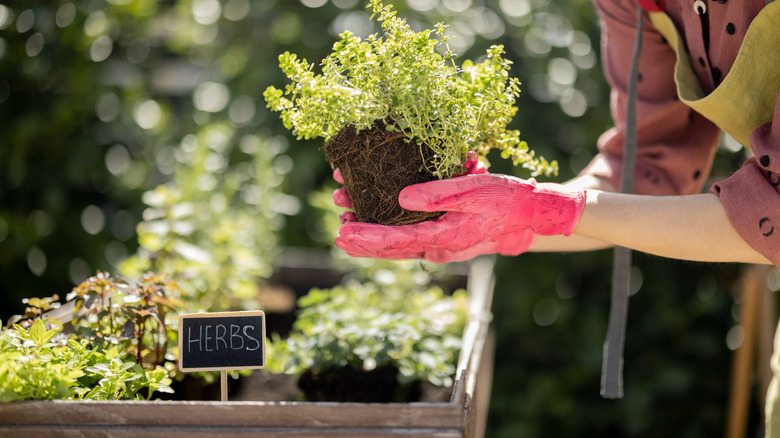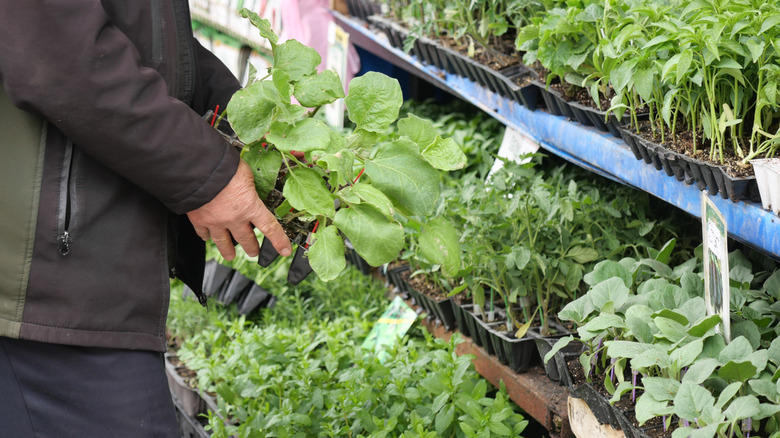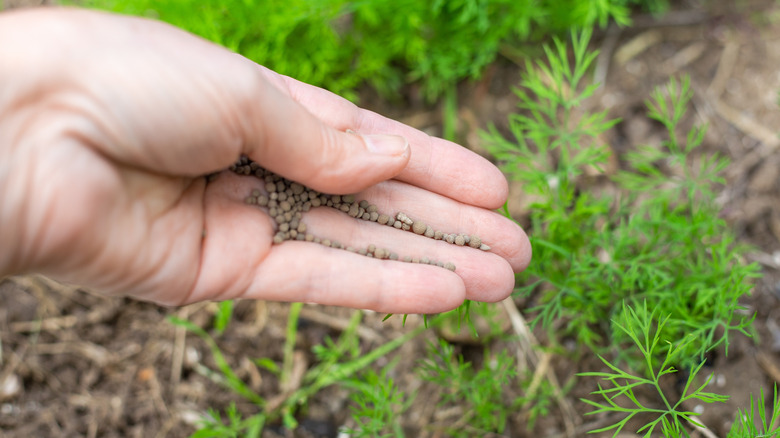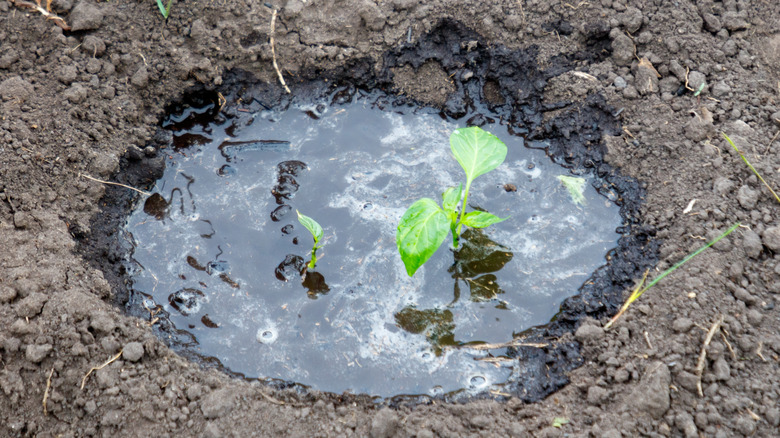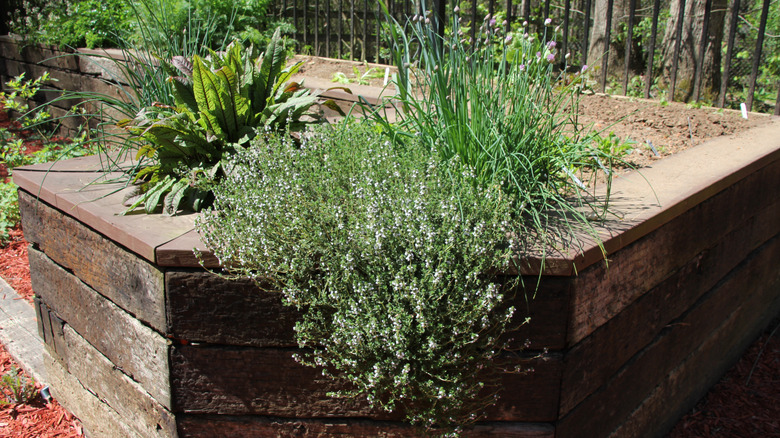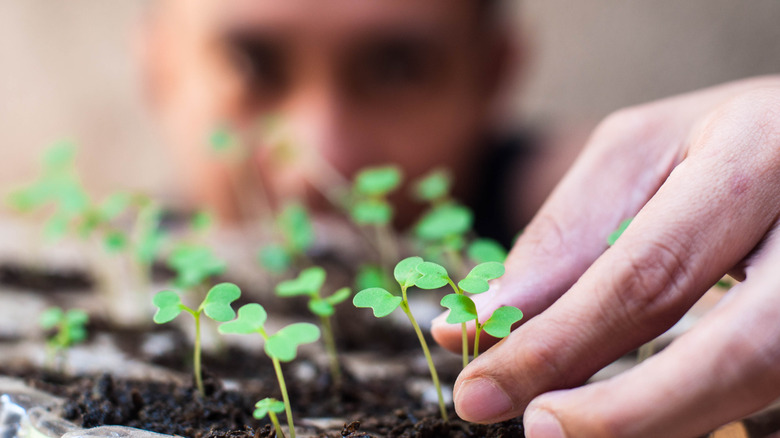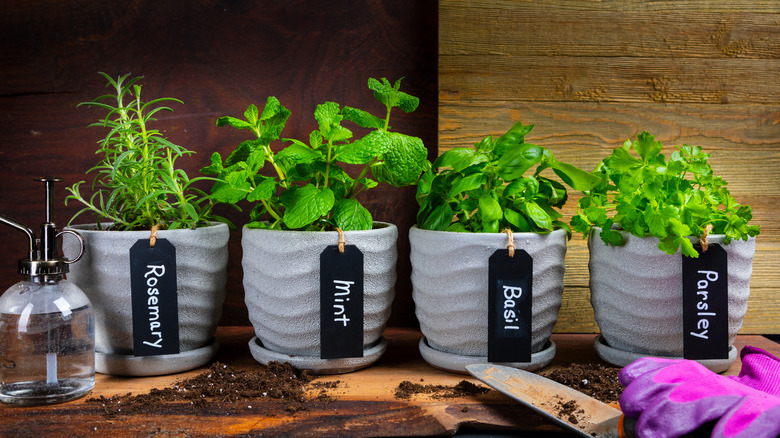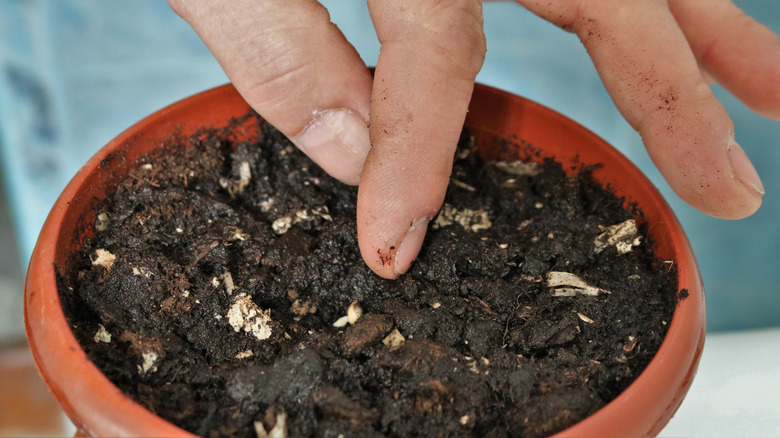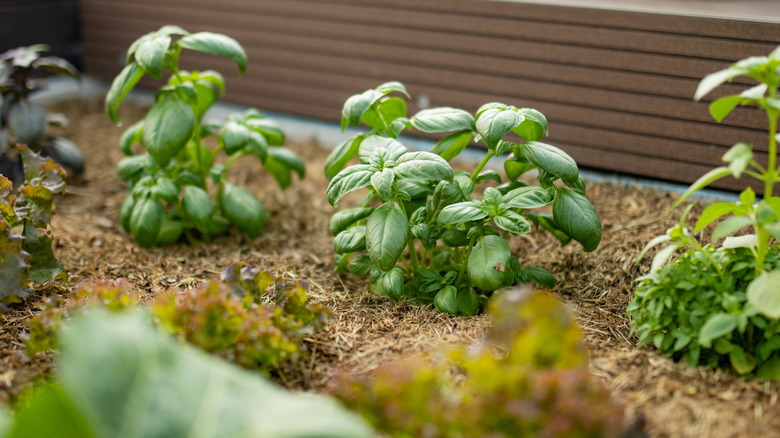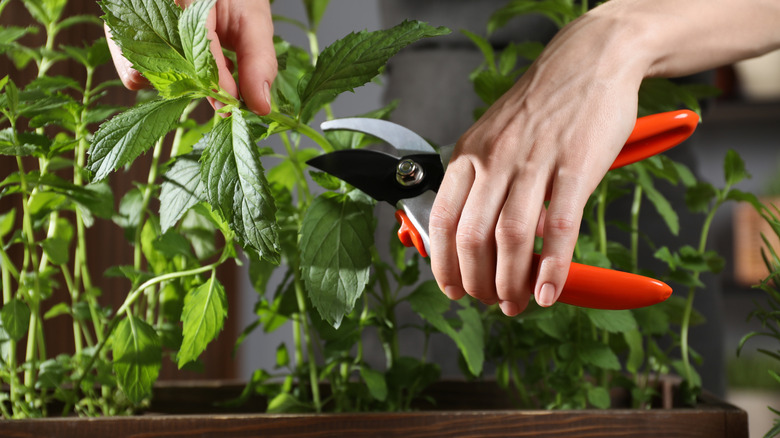10 Helpful Tips For Growing A Thriving Herb Garden
Whether you're working with a sprawling backyard or a sunny windowsill, cultivating your own herb garden can be both rewarding and practical. You no longer have to lose your cool over the ever-rising market prices for a wilted herb bunch that will look even more pitiable in a week or so. Instead, you can simply pluck the edible flowers and leaves right off the plant, cooking up the appetite further while the meal's getting ready. Their tolerance for diverse conditions makes herbs the perfect type of plant to grow if you don't have a green thumb. You may also want to grow them to support local pollinators, which are experiencing a steady decline in their population.
Irrespective of the reason underscoring your need for an herb garden, you can always implement more measures to ensure its continued growth and health. The key to a thriving herb garden lies in appreciating that different herbs have varying needs. Learning when to sow them directly or grow as transplants and investing in disease-resistant varieties ensures you start off on the right foot. Grouping herbs based on their water, fertility, and cultural requirements can further set you up for success. Utilizing nifty tricks like drainage and the finger test can also enhance your gardening experience. Ready to become a successful herb cultivator? Let's discuss some of the best tips and tricks for growing a thriving herb garden.
Know which herbs to buy as transplants and which to sow direct
Nothing derails an herb garden faster than starting it incorrectly. Like all plants, herbs have their quirks, with some performing better as transplants and others growing best when you sow them directly. For instance, rosemary and winter savory take too long to germinate. So, if you grow them as seeds, you'd be looking at bare beds for months. And when they finally sprout seedlings, you may have to use Google Lens or Picture This to determine whether they're your prized herb or a nuisance weed. Another disadvantage is that not many strong-flavored herbs, like oregano, thyme, sage, chives, mint, tarragon, and basil, return reliably with the same taste profile if grown from saved seeds. So, unless you want to wind up with bland seasonings, purchase their starts instead. Don't forget to ensure they have a healthy root system, and their foliage is perky and disease-free.
This doesn't mean you should never buy herbs as seeds. This can be a good idea if the herbs respond poorly to transplantation or germinate easily from seeds. Herbs related to the carrot family — think parsley, cilantro, dill, and fennel — produce delicate taproots that may never recover from being transplanted. Anise, borage, chervil, and caraway face similar transplantation challenges. Saddling your soil with a bunch of shocked plants that will never grow out or yield poorly won't give you a thriving herb garden. In short, always check whether the herbs grow better vegetatively (your cue to buy transplants) or from seeds.
Look for disease-resistant and improved varieties
While herbs are generally considered low maintenance, they aren't completely immune to diseases. Any spore or nematode buildup in the soil, poor cultivation practices, or lack of crop rotation can make herbs susceptible to root and foliar diseases. This may force you to use chemical controls, making the environment inhospitable to local pollinators. That's why investing in disease-resistant varieties (whenever they're available) can bring you a step closer to cultivating a healthy herb garden. However, note that such varieties aren't wholly impervious to disease outbreaks. They simply exhibit greater forbearance and tolerance to certain diseases. Moreover, they're resistant only to the select disease listed on their label and may remain vulnerable to other common illnesses.
For instance, consider the 'Gorizia' rosemary cultivar. You can count on it to withstand mildew pressure, especially if your herb is sited in humid grounds or doesn't receive much air because you're tardy about pruning. Similarly, if your area has a history of basil downy mildew, a fungal disease that causes leaf discoloration, look for basil options with "DMR" in their names, such as 'Obsession DMR,' 'Devotion DMR,' and 'Passion DMR'. Alternatively, you may switch over from sweet basil to hoary or red-leafed varieties, which can better withstand downy mildew. For lavender, consider cultivars like 'Phenomenal,' which has a superior disease resistance and wide tolerance for heat and cold.
Don't over-fertilize your herbs
If you've been feeding your basil plant weekly to encourage fast, lush growth, it most probably tastes bland. While you may be tempted to fertilize your herbs regularly to have them ready for summer get-togethers, the truth is you're robbing your plants of their organic flavor. When overfertilized or planted in overly rich soils, herbs feel encouraged to prioritize shoot growth and sacrifice their characteristic fragrant oils. Instead, grow them in average garden soil with moderate fertility levels.
To put this into perspective, unless you're blessed with loam soil, add organic amendments or compost to turn your sandy, clay, or compacted soils into a suitable growing medium. That said, don't go all-out on full-strength fertilizers. Plan your feeding schedules as you would for a vegetable garden, adding a single dose of slow-release fertilizer in the growth season — or not at all for perennial herbs. However, if you're the type to regularly harvest the herbs or grow them in containers, fertilize more to replace the nutrients or compensate for the limited access. If you're growing high-nutrient crops, like basil, group them with other plants with similar requirements, so the rest of your herb garden can thrive.
Pay attention to drainage
Ever had lavender die on you prematurely, refusing to return next spring? Odds are it's more to do with wet feet rather than the sudden winter temperature drop. Most herbs that grow in home gardens trace their origin to the Mediterranean region, where their natural habitats remain dry — even during the winter. Consequently, they dislike poor drainage and signal their disapproval with poor growth. Sadly, herbs stressed by waterlogging don't survive for long.
If you're unsure about the soil's drainage capacity, test it. Stake out an area and dig a 1-foot-wide hole that's similarly deep. Pour in water until it's level with the soil surface and track the time it takes to drain out. If the hole becomes dry within a day, your herb garden will do just fine. If not, you may need to consider other measures. The easiest step is to build raised beds and top them with good-quality soil. This will prove particularly beneficial in cold climates with short growing seasons, as soils warm faster in raised beds. Plus, you'll be doing your back a huge favor. But if you're a few months early and don't mind getting down and dirty, consider adding coarse mulch, such as wood chips, pine bark, pistachio shells, sand, grit, or pea gravel, to the soil for better drainage.
Group herbs with similar water needs in garden beds
One companion planting mistake everyone makes when designing their herb garden is teaming the plants without any regard for their watering requirements. Sure, your drainage game is on point, or you've planted the herbs in berms. But imagine if you coupled rosemary with basil or comfrey in the bed — that blue-flowering aromatic herb will rot!
Remember, your herb garden will prosper only when each herb's specific irrigation demands are met. Fortunately, it's easier to accomplish than you think. If your chosen herbs are Mediterranean natives, like rosemary, lavender, thyme, tarragon, borage, and oregano, they likely have low water demands, are drought tolerant, and can be planted together for a more successful herb garden. Herbs like African blue basil, chives, and lemon verbena also have similar demands and can be grouped with them. In contrast, herbs with fleshier roots, such as basil, comfrey, monarda, and lemongrass, tend to be water-thirsty and should be planted separately in moist sites.
Put simply, group woody or gray-leaved Mediterranean herbs separately, as they all have low irrigation needs. On the other hand, fleshy herbs should be located in consistently watered beds. If it's not possible or you mix the two groups, employ a drip irrigation system and organize different emitters that best match their water needs to keep your herb garden alive.
Space seedlings according to their mature size
The overlooked mistake that's making your garden beds look bad is overcrowding. Worse, growing the plants in extreme proximity may adversely affect their health and vigor. When you space herb seedlings willy-nilly without taking their mature size into account, you expose them to all sorts of problems. Spaced closely, these growing plants compete for sunlight, nutrients, and other resources, leading to lanky, spindly, or droopy growth. Assuming they survive, such overcrowding blocks the airflow, turning the planting site into a hotbed for diseases. If common pests, such as aphids, thrips, and whiteflies, invade your herb garden, they can quickly spread from one plant to the next, decimating it entirely.
To help your herb garden thrive and avoid such pitfalls, check the nursery tags or seed labels and space the seedlings according to their expected mature width. For instance, large herbaceous shrubs that tend to spread, like rosemary, can be spaced about 2 to 3 feet away. Contrarily, tiny herbs, including anise, caraway, and chervil, can be tucked in just 6 inches apart. That being said, if you're dealing with limited acreage and have planted herbs in containers, you can risk planting them closer, provided you increase watering and fertilization accordingly.
Consider growing herbs in containers
If you struggle to keep herbs alive and fail to emulate their desired conditions, consider planting or moving them to containers. This will solve a wide range of problems. For starters, if you're growing lavender or parsley, which dislike afternoon heat, simply move the container to a shaded spot during the hottest time of day. Similarly, if you're worried about the relentless rains or the accompanying humidity damaging the more delicate herbs, like chamomile, cumin, and cilantro, move the pots to a more protected site.
Container gardening is also convenient for tender perennial herbs, such as lemongrass. You can overwinter them inside when temperatures plummet or frost hits. Another benefit? If you love mint, marjoram, chives, peppermint, catnip, monarda, anise, or sweet woodruff but don't want to plant these herbs in your garden, pop them in containers to limit their aggressive tendencies. That being said, there's also anecdotal evidence about some herbs, such as sage, oregano, and summer savory, liking pots better than in-ground plantings. That said, choose your containers properly. If you tend to forget to water plants, keep them in large containers. If you're growing herbs that require well-draining soil, drop them in terracotta pots rather than in plastic or glazed ceramic urns.
Use the finger test before watering
Let's be honest: Despite all the well-meaning recommendations floating about, it's difficult to determine the best time to water your herbs. And this can be problematic. The leading reason herbs die prematurely is because of an overabundance of water — not a lack of it. Overwatering can induce root rot or a disease outbreak, which doesn't make for a good prognosis for the affected herbs.
You can take the guesswork out of the equation and ensure your herb garden's health by following a simple finger test. When the soil starts to appear dry, simply poke your finger into the substrate about 2 inches deep and check whether it comes out moist. If it's dry, you can water the herbs. Otherwise, you must wait longer to run the hose or tap (for containers). However, be sure not to wait exceedingly long. This is because the lack of water cause leaf wilt and successful recuperation may not always be possible.
Use mulch strategically to smother weeds, protect herbs from frost, and inhibit disease
Weeds spell trouble as they muscle their way through and jostle around for essential nutrients. Sadly, herb gardens aren't untouched by their presence. But you can keep your herb garden healthy and suppress these uninvited guests as they're germinating. Mulch the herbs” bases to choke off weed seedlings' access to light. Mulching also helps retain the soil's moisture and keeps the plant roots cool, which is important in hot climates, where extreme heat and droughts are the norm.
Mulch can also protect tender or hardy perennials from frost damage. Since most of these herbs die back to the ground once frost hits, topping straw or compost on the soil keeps it warm until the plants return with the spring. Factor in the plant's size before deciding how thickly you should lay down the mulch. Don't go over 2 inches if the plants are small. For sprawling shrubs, you may go as high as 5 inches after freezing temperatures have set in, so their winter resilience remains intact.
Another reason to mulch your herb gardens is to minimize disease pressure. Strategically applied mulch — especially inorganic varieties like stones or pea gravel — can prevent soil pathogens and fungal spores from launching onto the foliage during rains. This lowers disease pressure, ensuring your herb garden remains healthy. As a bonus, it prevents dust and dirt from latching onto the leaves, which could (temporarily) make the idea of harvesting and consuming the herbs unappetizing.
Prune or harvest aggressively to maintain plant vigor
This might trip a few gardeners, but pruning or harvesting regularly can, in fact, improve your herb garden's productivity and vigor. The reasoning? When you remove the old growth or the emergent buds and flowers, you redirect the plant's energy into pushing out new growth instead of preserving its legacy by setting seeds.
Indeed, it helps to pinch off the stem tips from spring through summer, so the herbs grow bushier and remain productive — pineapple sage and calendula benefit from this practice particularly. For annual herbs, like basil, thyme, and parsley, harvesting should begin when they grow about 6 to 8 inches tall. Also, trim them aggressively in late summer, so you may still enjoy some offshoots before they're finally killed by the frost. In the case of perennial herbs, simply clip off the top 2 inches or as close as possible to the next tender growth every week when harvesting. Or you could cut back half the plant to encourage faster regrowth. However, avoid intensive pruning when plants are undergoing drought stress or when they're getting ready for winter.
